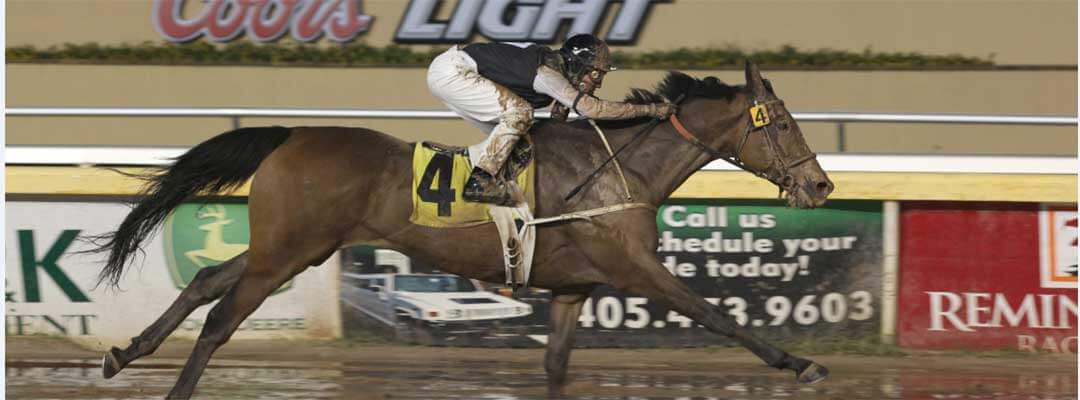
The racing career of Thoroughbred mare, Miss Hockaday, was an immediate success, with career earnings amounting to nearly $262,000, spanning across Oklahoma, Texas, Arkansas and Iowa.
With a champion bloodline harkening to Thoroughbred greats like Seattle Slew and Northern Dancer, owner-trainer, husband-and-wife duo, Jearl (Ace) and Randy Hare, decided her second career would be as a broodmare, continuing on her legacy.
“To see Miss Hockaday’s racing success, and to continue her on as a broodmare, was amazing,” said Randy Hare, co-owner of Hare Racing Stables in Oklahoma City. “She ran a lot of races and beat a lot of great horses. With such high earnings, we only paid $800 for her. It was a very exciting time, and she retired from racing completely sound.”
With her success on the track, it was a paramount decision to select the best possible sire for Miss Hockaday’s first foal.
“Living in Oklahoma, we don’t have a large pool of premier stallions to choose from,” said Hare. “I got her to the best stallion I could, and that was in Kentucky.”
Miss Hockaday was bred to a leading sire, Shackleford, who after retiring in 2012 with $3,090,101 in earnings, cashed in with an initial stud fee of $20,000. The foal, Hareraising, was sold at Keeneland and soon embarked on her racing career.
A mare’s health leading up to breeding is critical for the success of conception, as well as a healthy foal.
Consider These 6 Important Factors for Broodmares and Successful Breeding
- Suppress estrus for improved fertility with Regu-Mate®, Altren® Or Ovamed®.
Estrus suppression will help you predict estrus, as well as improve a mare’s fertility. Regu-Mate facilitates breeding earlier in the season by helping transitional mares cycle regularly. Scheduled breeding with Regu-Mate helps breeding barns manage costs of shipped semen, reduce number of stallion collections needed and schedule the estrous cycles of donor and recipient mares for embryo transplants. By administering Regu-Mate or Ovamed®, mares will return to estrus within five days following treatment. - Ensure mares are at a healthy weight.
Mares should enter the breeding season fit and gaining weight for better chances of successful conception, according to the American Association of Equine Practitioners (AAEP). - Eliminate stress as much as possible.
Stress can cause a mare’s level of Progesterone to drop. This hormone is critical to maintain pregnancy. Illness can cause the mare's system to secrete prostaglandins, which may cause foal loss (commonly referred to as abortion), according to the AAEP. - Maintain current vaccinations.
Protect against abortions in pregnant mares through vaccinations against Eastern and Western encephalomyelitis, West Nile virus, influenza and tetanus at the beginning of pregnancy. Administer booster vaccinations one month before foaling to increase the antibody level in the mare's colostrum to help protect the newborn foal from disease risk. The AAEP also recommends mares be vaccinated against equine rhinopneumonitis at five, seven and nine months' gestation. - Protect the mare and foal from parasites.
As the mare is the primary source for her foal’s parasite risk, it is important for her to be on a safe and effective deworming schedule, with guidance on frequency and timing provided by your veterinarian. - Ensure nutritional needs are met.
As the foal continues to grow, especially during the last four months of pregnancy, a mare’s energy needs will increase. Provide enough quality forage and grain to meet these heightened energy requirements. When it comes time for your mare’s big day, make sure you have everything needed with this Professional Foaling Kit.
Continue on the legacy. Ensure successful conception through excellent broodmare health and these proven solutions for improved fertility, Regu-Mate and Ovamed.
All photographs and images courtesy of Valley Vet.
This article originally appeared on Valley Vet and is published here with permission. Valley Vet Supply was founded in 1985 by veterinarians for people just like you - people who want the very best for their four-legged friends and livestock.
There are more informative articles in our section on Health & Education.

































